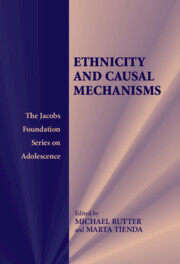Book contents
- Frontmatter
- Contents
- List of Contributors
- Foreword
- Preface
- 1 Natural Experiments, Causal Influences, and Policy Development
- 2 Growing Up Ethnic in the United Kingdom and the United States: Comparative Contexts for Youth Development
- 3 The Multiple Facets of Ethnicity
- 4 Educational Attainments: Ethnic Differences in the United Kingdom
- 5 Race and Ethnic Inequality in Educational Attainment in the United States
- 6 Racial and Ethnic Disparities in Crime and Delinquency in the United States
- 7 Explaining Ethnic Variations in Crime and Antisocial Behavior in the United Kingdom
- 8 Cultural Differences in the Effects of Physical Punishment
- 9 Ethnicity and Mental Health: The Example of Schizophrenia in the African-Caribbean Population in Europe
- 10 Ethnic Variations in Youth Suicide
- 11 Ethnicity and Intergenerational Identities and Adaptations in Britain: The Socio-Political Context
- 12 Assimilation, Dissimilation, and Ethnic Identities: The Experience of Children of Immigrants in the United States
- 13 Deciphering Ethnicity: Reflections on Research Opportunities
- Author Index
- Subject Index
12 - Assimilation, Dissimilation, and Ethnic Identities: The Experience of Children of Immigrants in the United States
Published online by Cambridge University Press: 05 July 2014
- Frontmatter
- Contents
- List of Contributors
- Foreword
- Preface
- 1 Natural Experiments, Causal Influences, and Policy Development
- 2 Growing Up Ethnic in the United Kingdom and the United States: Comparative Contexts for Youth Development
- 3 The Multiple Facets of Ethnicity
- 4 Educational Attainments: Ethnic Differences in the United Kingdom
- 5 Race and Ethnic Inequality in Educational Attainment in the United States
- 6 Racial and Ethnic Disparities in Crime and Delinquency in the United States
- 7 Explaining Ethnic Variations in Crime and Antisocial Behavior in the United Kingdom
- 8 Cultural Differences in the Effects of Physical Punishment
- 9 Ethnicity and Mental Health: The Example of Schizophrenia in the African-Caribbean Population in Europe
- 10 Ethnic Variations in Youth Suicide
- 11 Ethnicity and Intergenerational Identities and Adaptations in Britain: The Socio-Political Context
- 12 Assimilation, Dissimilation, and Ethnic Identities: The Experience of Children of Immigrants in the United States
- 13 Deciphering Ethnicity: Reflections on Research Opportunities
- Author Index
- Subject Index
Summary
Introduction
The immigrant-stock population of the United States – the foreign born and their U.S.-born children – surpassed 60 million people in the year 2000, a total larger than the entire population of the United Kingdom. The Current Population Survey estimated that there were 32.5 million foreign-born persons in the United States in 2002, and nearly another 30 million U.S.-born persons with at least one foreign-born parent, comprising 22 percent of the total U.S. population (Rumbaut, 2002; Schmidley, 2003). The foreign born are fairly recent arrivals: almost half arrived in the United States since 1990, and another quarter entered during the 1980s. This “new” immigration – largely from Asia, Latin America, and the Caribbean, with smaller but growing components from Europe, Africa, and the Middle East – has been changing fundamentally the racial and ethnic composition and stratification of the American population, as well as the social meanings of race and ethnicity and of American identity. The immigrants and their children are forming the emerging ethnic groups of the United States in the 21st century, even as they are themselves being transformed into the newest Americans. Their intergenerational evolution may produce new ethnic formations and identities, even as the process of “becoming American” has come to include the adoption or rejection of a set of officially constructed pan-ethnic labels such as “Hispanic” and “Asian/Pacific Islander,” which lump together scores of nationalities into one-size-fits-all minority group categories – and which may, unwittingly, institutionalize not their assimilation but their dissimilation.
- Type
- Chapter
- Information
- Ethnicity and Causal Mechanisms , pp. 301 - 334Publisher: Cambridge University PressPrint publication year: 2005
- 2
- Cited by



